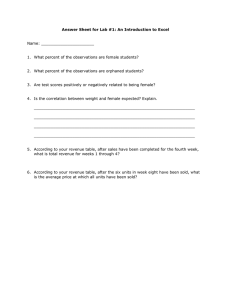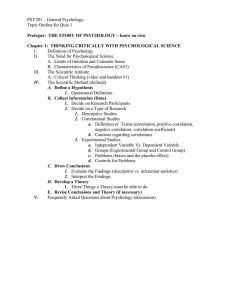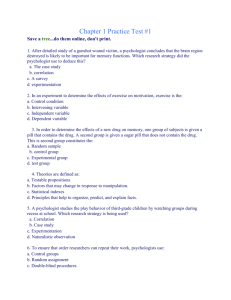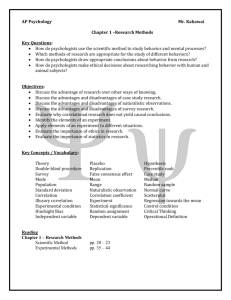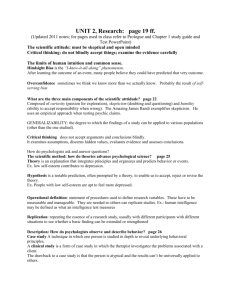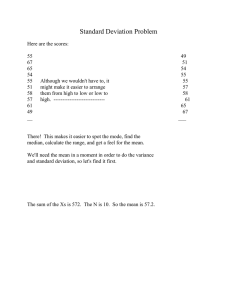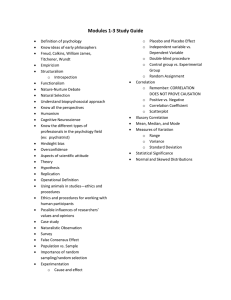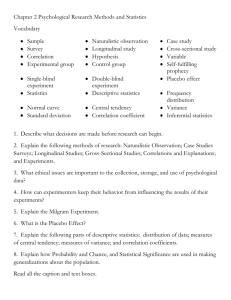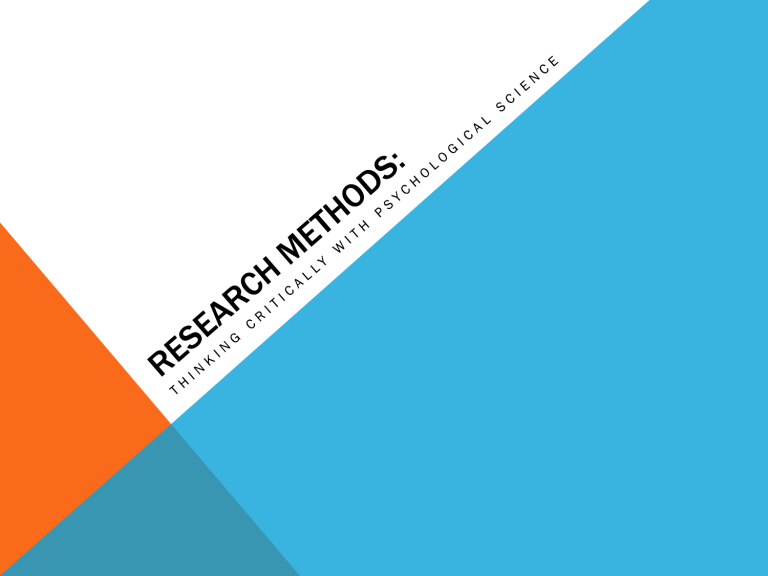
RESEARCH METHODS 8-10% WE WILL COVER Experimental, Correlational, and Clinical Research Statistics Descriptive Inferential Ethics in Research STUDENTS SHOULD BE ABLE TO: Differentiate types of research with regard to purpose, strengths, and weaknesses Describe how research design drives the reasonable conclusions that can be drawn Identify independent, dependent, confounding, and control variables in experimental designs Distinguish between random assignment of participants to conditions in experiments and random selection of participants, primarily in correlational studies and surveys STUDENTS SHOULD BE ABLE TO: Predict the validity of behavioral explanations based on the quality of research Distinguish the purposes of descriptive statistics and inferential statistics Apply basic descriptive statistical concepts, including interpreting and constructing graphs and calculating simple descriptive statistics Discuss the value of reliance on operational definitions and measurement in behavioral research STUDENTS SHOULD BE ABLE TO: Identify how ethical issues inform and constrain research practices Describe how ethical and legal guidelines protect research participants and promote sound ethical practice KEY TERMS Hindsight Bias Critical Thinking Theory Hypothesis Operational Definition Replication Case Study Survey KEY TERMS Population Random Sample Naturalistic Observation Correlation Correlation coefficient Scatterplot Illusory Correlation Experiment Random Assignment KEY TERMS Double-Blind Procedure Placebo Effect Experimental group Control group Independent Variable Confounding Variable Depending Variable KEY TERMS Mode Mean Median Range Standard Deviation Normal Curve Statistical Significance Culture Informed Consent Debriefing KEY PEOPLE Kenneth Clark Mamie Phipps Clark Daniel Kahneman James Randi Amos Tversky 2 PHENOMENA IN RESEARCH THAT ILLUSTRATE WHY WE CANNOT RELY SOLELY ON INTUITION AND COMMON SENSE Hindsight bias Judgmental overconfidence HINDSIGHT BIAS The tendency to believe, after learning an outcome, that one would have foreseen it “I knew it all along” Finding that something has happened makes it seem inevitable HINDSIGHT BIAS Just asking people how and why they felt or acted as they did can sometimes be misleading- NOT because common sense is usually wrong, but because common sense more easily describes what HAS happened that what WILL happen EXAMPLE OF ERRORS IN CRITICAL THINKING 1995 Oklahoma City Bombings Alerts issued for suspicious-looking persons of Middle Eastern or Arabic decent Believed Muslim extremists were at fault Real perpetrator was Timothy McVay White male Disgruntled at the government’s involvement with the events in Waco, TX 5 years earlier TRUE OR FALSE? If you want to teach a habit that persists, reward the desired behavior every time, not just intermittently. FALSE TRUE OR FALSE? Patients whose brains are surgically split down the middle survive and function much as they did before the surgery. TRUE TRUE OR FALSE? Traumatic experiences, such as sexual abuse or surviving the Holocaust, are typically “repressed” from memory. FALSE TRUE OR FALSE? Most abused children do NOT become abusive adults. TRUE TRUE OR FALSE? Adopted siblings usually do not develop similar personalities, even though they are reared by the same parents. TRUE TRUE OR FALSE? The brain remains active during sleep. TRUE TRUE OR FALSE? Most infants recognize their own reflection in a mirror by the end of their first year. FALSE TRUE OR FALSE? Fear of harmless objects, such as flowers, are just as easy to acquire as fears of potentially dangerous objects, such as snakes. FALSE TRUE OR FALSE? Most of us use only about 10% of our brains. FALSE TRUE OR FALSE? Lie detection tests often lie. TRUE PREDICTION TIME Predict what grade you will get on your next quiz or test. Rate on a scale 1-10, how confident you are about your prediction. WHAT KIND OF SCIENTIST WOULD ANSWER THESE QUESTIONS? What parts of our brain do we use to feel happy? How do we see color? What happens in the brain when we dream? In what ways does background noise affect our ability to pay attention? WHAT KIND OF SCIENTIST WOULD ANSWER THESE QUESTIONS? Psychologists!!!! OVERCONFIDENCE We tend to be overconfident and think we know more than we do Consider these three anagrams people were asked to unscramble: WREAT = WATER ETRYN = ENTRY GRABE = BARGE How many seconds do you think it would have taken you to unscramble them? OVERCONFIDENCE Knowing the answer, hindsight makes it seem obvious, and people think it would only take about 10 seconds, when in reality, people spend about 3 minutes to solve the problem. OVERCONFIDENCE OCHSA OVERCONFIDENCE CHAOS Hindsight bias and overconfidence often lead us to overestimate our intuition. But scientific inquiry can help us sift reality from illusion. SCIENTIFIC ATTITUDE Putting a scientific attitude into practice requires not only skepticism but also humility- an awareness of our own vulnerability to error and an openness to surprises and new perspectives. Curiosity Skepticism Humility These 3 attitudes helped make modern science possible GENERALIZABILITY Degree the results of a study can be applied to different types of populations CRITICAL THINKING The scientific attitude prepares us to think smarter. Smart thinking, called critical thinking, examines assumptions, discerns hidden values, evaluates evidence, and assesses conclusions. HOW DO PSYCHOLOGIST ASK AND ANSWER QUESTIONS? Scientific Method Psychological science evaluates competing ideas with careful observation and rigorous analysis. Attempts to describe and explain human nature Welcomes hunches and plausible-sounding theories Then puts it to the test If data support its prediction- so much the better for the theory If the predictions fail, the theory will be revised or rejected SCIENTIFIC METHOD Scientific Method A self-correcting process for asking questions and observing nature’s answers. Theory An explanation using an integrated set of principles that organizes observations and predicts behaviors or events Hypotheses A testable prediction, often implied by a theory SCIENTIFIC METHOD A hypothesis is a statement of relationship between or among variables. Psychologists generate these statements after researching what other scientists have learned and observing variables in the environment SCIENTIFIC METHOD Theories are generally highly researched, rigorously tested frameworks that organize multiple studies under one umbrella of ideas. Theories are tested ideas and not just educated guesses Theories are NOT the product of guesswork as hypotheses are SCIENTIFIC METHOD There are too many facts about behavior to remember them all. By linking facts and bridging them to deeper principles, a theory offers a useful summary. As we connect the observed dots, a coherent picture emerges. SCIENTIFIC METHOD A good theory produces testable predictions, called hypotheses. By enabling us to test and to reject or revise the theory, such predictions five directions to research. Hypotheses specify what results would support the theory and what results would disconfirm it. SCIENTIFIC METHOD Theories Research and observations Hypotheses SCIENTIFIC METHOD Hypothesis leads to research which leads to theories which lead to more hypotheses. The scientific process is a creative process because of the feedback loop. SCIENTIFIC METHOD Good theories explain by Organizing and linking observed facts Implying hypotheses that offer testable predictions and, sometimes, practical applications SCIENTIFIC METHOD Operational definition A statement of the procedure (operations) used to define research variables. Ex: human intelligence may be operationally defined as what an intelligence test measures The most important part of the research study, because it defines what the researcher will be observing and manipulating Needs to be 1) measurable and 2) manageable SCIENTIFIC METHOD Operational definitions help psychologists to keep a check on their biases These carefully worded statements would allow others to replicate the original observations. If other researches re-create a study with different participants and materials and get similar results, then our confidence in the finding's reliability grows. OPERATIONAL DEFINITIONS Happiness A smile Intelligence Popularity Good music SCIENTIFIC METHOD ****Replication is the main goal of all good research***** SCIENTIFIC METHOD We test our hypotheses and refine our theories using descriptive methods (which describe behaviors, often using case studies, surveys, or naturalistic observation), correlational methods (which associate different factors) and experimental methods (which manipulate factors to discover their efforts. DESCRIPTION The starting point of any science is description Describes behaviors using: Case studies Surveys Naturalistic observation Describes behavior; does not Explain behavior CASE STUDY Among the oldest research methods Examines one individual in depth in hopes of revealing things true of us all Often suggest directions for further study Show us what can happen CASE STUDY Some of the most famous psychological phenomena are based on case study research Psychoanalysis Sigmund Freud and Carl Jung developed much of their theories on human personality based on case studies Behaviorism John Watson and Rosalie Rayner conducted an intensive experiment knows as the “Little Albert” study to demonstrate classically conditioned emotions. Little Albert was trained to fear white, furry objects by associating those objects with a loud noise CASE STUDY (CON’T) Neuroscience Paul Broca had a patient who could only utter one syllable: “Tan” Upon Tan’s death, Broca studied the patient’s brain, hypothesizing that the damaged area was where our ability to speak lies. SURVEY Looks at many cases in less depth Use this method when wanting to estimate, from a representative sample of people, the attitudes or reported behaviors of a whole population SURVEY Wording Effects Even subtle changes in the order or wording of questions can have major effects Phrasing of a question might affect people’s expressed opinions Random Sampling For an accurate picture of a whole population's attitudes and experiences Involves choosing at random participants from a larger population Takes the randomly chosen sample and assigning them, at random, to either the experimental or control group (in experiments) RANDOM SAMPLE Typically generates a representative sample Random sample and representative sample are similar and often are referring to the same group of participants in a research study SURVEY Point to remember: The best basis for generalizing is from a representative sample of cases. Point to remember: Before accepting survey findings, think critically. Consider the sample. NATURALISTIC OBSERVATION Records behavior in natural environments. Range from watching to unobtrusively videotaping Offers interesting snapshots of everyday life, but it does so without controlling for all the factors that may influence behavior. DESCRIPTION Describing behavior is the first step toward predicting it. CORRELATION What are positive and negative correlations, and why do they enable prediction but not cause-effect explanation? CORRELATION When one trait or behavior is related to another, we say the two correlate. A statistical measure (correlation coefficient) helps us figure how closely two things vary together, and thus how well either one predicts the other. CORRELATION Positive Correlation Two sets of scores tend to rise or fall together Ex: Height and weight Negative Correlation Two sets of scores relate inversely Exercise and weight Weak Correlation Indicating little relationship Near zero CORRELATION Positive correlations are also knows as direct correlations. The variables have a direct relationship between them As one increases or decreases, so does the other in the same direction Negative correlations are also knows as inverse correlations. Inverse relationship, as one increases the other decreases POSITIVE OR NEGATIVE? The more young children watch TV, the less they read. The more sexual content teens see on TV, the more likely they are to have sex. The longer children are breast-fed, the greater their later academic achievement. The more often adolescents eat breakfast, the lower their body mass. PERFECT POSITIVE CORRELATION (+1.0) 3,5 3 2,5 Column2 Series 2 Column1 2 1,5 1 0,5 0 Category 1 Category 2 Category 3 Category 4 PERFECT NEGATIVE CORRELATION (-1.0) 4,5 4 3,5 3 2,5 2 1,5 1 0,5 0 Series 1 Column2 Column1 Category 1 Category 2 Category 3 Category 4 NO RELATIONSHIP Y-Values 3,5 3 2,5 2 Y-Values 1,5 1 0,5 0 0 0,5 1 1,5 2 2,5 3 CORRELATION Point to remember: A correlation coefficient, which can range from -1.0 to +1.0, reveals the extend to which two things relate. Correlations help us to predict Point to remember: Correlation indicates the possibility of a cause-effect relationship, but it does not prove causation. Knowing that two events are associated need not tell us anything about causation. CORRELATION Correlation does not mean causation. Correlation tells you that certain variables are related but not why they are related The number represents the strength of a relationship, the sign represents the direction of the correlation. ILLUSORY CORRELATION A perceived but nonexistent correlation When we believe there is a relationship between 2 things, we are likely to notice and recall instances that confirm our belief Often influenced by confirmation bias. We tend to look for evidence that confirms our beliefs and ignore evidence that disconfirms our beliefs. ILLUSORY CORRELATION Point to remember: When we notice random coincidences, we may forget that they are random and instead see them as correlated. Thus, we can easily deceive ourselves by seeing what is not there. Couples getting pregnant after adopting EXPERIMENTATION How do experiments, powered by random assignment, clarify cause and effect? EXPERIMENTS Experiments enable a researcher to focus on the possible effects of one or more factors by Manipulating the factors of interest and Holding constant (“controlling”) other factors **The only type of study that can determine cause-and-effect KEY TERMS Experimental group The group exposed to the treatment Control group The group that is not exposed to the treatment Independent variable The experimental factor that is being manipulated Dependent variable The outcome factor Confounding variable A factor other than the independent variable that might produce an effect in an experiment RANDOM ASSIGNMENT Assigning participants to experimental or control groups by chance, thus, minimizing preexisting differences between those assigned to the different groups Also helps to control for confounding variables Helps us generalize to a larger population Controls extraneous influences, which helps us infer cause and effect TWO MAIN WAYS TO GROUP PARTICIPANTS IN AN EXPERIMENT Within-subjects design Between-subjects design WITHIN-SUBJECTS DESIGN • Involves comparing participants to themselves. Typically the research will give the participant a pre-test. All of the participants will be exposed to the independent variable and the will take a post test. In this design, the participants serves as their own control group. Less efficient, but more resistant to the effects of individual differences, because participants are compared to themselves BETWEEN-SUBJECTS DESIGN Involves comparing one group of participants to another. This is the most common experimental set up. Only one group in this design is exposed to the independent variable. Can conduct the research in one sitting However, individual differences are more likely to influence POINT TO REMEMBER: Unlike correlational studies, which uncover naturally occurring relationships, an experiment manipulates a factor to determine it’s effect. PLACEBO EFFECT A phenomenon in which people believe a treatment will work simply because their care provider tells them it will. In these cases, being treated by a trusted source seemingly derives a health benefit EXPERIMENT EXAMPLE To test the effect of perceived ethnicity on the availability of a rental house, 2 researchers sent identically worded e-mail inquires to 1115 Los Angeles-area landlords. The researches varied the ethnic connotation of the sender’s name and tracked the percentage of positive replies. RESULTS Patrick McDougall Said Al-Rahman Tyrell Jackson Patrick McDougall- 89% Said Al-Rahman – 66% Tyrell Jackson – 56% TEST YOUR KNOWLEDGE In this experiment: What was the independent variable? What was the dependent variable? RECAP: A variable is anything that can vary Experiments aim to manipulate an independent variable, measure the dependent variable, and control confounding variables. An experiment has at least 2 groups Experimental group Control group Random assignment works to equate the groups before any treatment effects RECAP: Case studies and naturalistic observations only describe behavior. Correlations can be used to predict future phenomena Experiments determine cause and effect DESCRIPTIVE Basic purpose Observe and record behavior How? Case studies, surveys, naturalistic observation What is manipulated? Nothing Strengths Can use only one, done quickly and inexpensive, don’t require manipulation Weaknesses No control of variables, single case may be misleading. CORRELATIONAL Basic purpose Detect naturally occurring relationships; assess how well one variable predicts another How? Compute statistical associations What is manipulated? Nothing Strengths Works with large groups of data, may be used in situations where an experiment would not be ethical or possible Weaknesses Does not specify cause and effect EXPERIMENTAL Basic purpose To explore cause and effect How? Manipulate one or more factors; use random assignment What is manipulated? The independent variable Strengths Specifies cause and effect, and variables are controlled Weaknesses Sometimes not feasible; results may not generalize to other contexts; not ethical to manipulate certain variables STATISTICAL REASONING IN EVERYDAY LIFE In Descriptive, Correlational, and Experimental research, statistics are tools that help us see and interpret what the unaided eye might miss. Doubt big, round, undocumented numbers. Rather than swallowing top-of-the-head estimates, focus on thinking smarter by applying simple statistical principles to everyday reasonsing DESCRIBING DATA **Think smart. When viewing figures in magazines and on television, read the scale labels and note their range** TYPE OF STATISTICS COMPUTED FOR A SET OF DATA DEPENDS ON WHAT TYPE OF DATA IS COLLECTED Nominal Simply identifies categories Ordinal Identifies the order in which data falls in a set Interval Includes data that falls within a number line that has a zero point Ratio Includes data that falls in a number line where zerio is just another number on the line MEASURES OF CENTRAL TENDENCY Must summarize data after it has been collected Measures of central tendency is a single score that represents a whole set of scores Mode Mean Median MODE The most frequently occurring score or scores MEAN The average of the scores Most commonly reported Most susceptible to extremes in the data This is the number that gets pulled up or down depending on how extreme the data points are MEDIAN The midpoint (arrange scores from highest to lowest) The 50th percentile (half will be above and half will be below) CENTRAL TENDENCY Refers to how the data measure the center of a set of data Mode, median, mean all point to where the middle of the data should be If mode, median, mean are all the same number, the graph of the data will look like a normal curve If different, the curve will be skewed SKEWED CURVES Positive Occurs when scores pull the mean toward the higher end of the scores The mean is more “positive” or greater than the rest of the scores Negative Occurs when scores pull the mean toward the lower end of the scores The mean is more “negative” or less than the rest of the scores CREATE YOUR OWN FREQUENCY TABLE AND CHART Collect heights of your peers Create a table In one column, put in all the various possible height in inches In another column, put how many students are at each specific height Create a graph Plot the points using a bar graph POINT TO REMEMBER: Always note which measure of central tendency is reported. Then, if it’s the mean, consider whether a few atypical scores could be distorting it. MEASURES OF VARIATION Knowing the value of an appropriate measure of central tendency can tell us a great deal But the single number omits other information. It helps to know something about the amount of variation in the data- how similar or diverse the scores are. Averages derived from scores with low variability are more reliable than averages based on scores with high variability STANDARD DEVIATION A more useful standard for measuring how much scores deviate from one another is the standard deviation Uses information from each score Can tell if scores are packed together or dispersed. STANDARD DEVIATION Tells us how different the scores are from each other Less variability is better than greater variability If a group of scores has a smaller standard deviation, then you can draw more stable conclusions from that data set. If set of scores has a large standard deviation, the conclusions you can draw are less stable STANDARD DEVIATION Knowing the Standard Deviation for a set of data can reveal how similar the scores are. The higher the Standard Deviation, the less similar the scores are Standard Deviation = The square root of- Sum of (deviations)2/ number of scores **Unlikely that you will have to calculate this on the AP Exam, but you may be asked to interpret it STANDARD DEVIATION Normal curve 68% of the scores fall within one standard deviation on either side of the mean 95% of the scores fall within 2 standard deviations MAKING INFERENCES When is an observed difference reliable? When deciding when it is safe to generalize from a sample, keep 3 principles in mind Representative samples are better than biased samples Less-variable observations are more reliable than those that are more variable More cases are better than few Averages based on many cases are more reliable (less variable) than averages based on only a few cases POINT TO REMEMBER: Don’t be overly impressed by a few anecdotes. Generalizations based on a few unrepresentative cases are unreliable MAKING INFERENCES When is a difference significant? When averages from 2 samples are each reliable measures of their respective populations (as when each is based on many observations that have small variability) then their difference is likely to be reliable as well When the difference between the sample averages is large, we have even more confidence that the difference between them reflects a read difference in their populations. LET ME RESTATE THAT When the sample averages are reliable, and when the difference between them is relatively large, we say the difference has statistical significance. This means that the observed difference is probably not due to chance variation between the samples. Proof beyond a reasonable doubt means not making much of a finding unless the odds of its occurring by chance are less than 5% STATISTICAL SIGNIFICANCE Refers to how 2 groups’ means are different. If you graphed the data from 2 groups and the graphs did not overlap or only overlapped a little, then the difference would be significant. If the graphs overlapped a lot, then the difference would not be significant Significance allows you to say how likely the difference in means is due to chance. Usual goals is to get a significance level of .05, which says that the results are only 5% due to chance EFFECT SIZE The measure of the strength of a relationship between variables is becoming the new way for researches to report their results POINT TO REMEMBER Statistical significance indicates the likelihood that a result will happen by chance. But this does not say anything about the importance of the result FREQUENTLY ASKED QUESTIONS ABOUT PSYCHOLOGY CAN LABORATORY EXPERIMENTS ILLUMINATE EVERYDAY LIFE? The experiment intends the laboratory environment to be a simplified reality- one that simulates and controls important features of everyday life A lab experiment lets psychologists re-create psychological forces under controlled conditions Purpose to not to re-create the exact behaviors of everyday life but to test theoretical principles It is the resulting principles, not the specific findings, that help explain everyday behaviors IMPORTANT!!! Controlling for cofounding, or extraneous, variables is the goal of the experimental method A highly-controlled experimental environment is not much like reality, but it does help simplify the complexity of the real world and helps provide a clearer picture of how variables in the real world work together IMPORTANT!! Experiments are more likely to be replicated effectively if clear operational definitions are used Operational definitions attempt to clearly define the behaviors that the researchers are looking for If the operational definitions are clear enough, then others can more easily and accurately replicate the study. POINT TO REMEMBER Psychologists concerns lie less with unique behaviors than with discovering general principles that help explain many behaviors. DOES BEHAVIOR DEPEND ON ONE’S CULTURE AND GENDER? We are each in certain respects like all others, like some others, and like no other. Studying pole of all races and cultures helps us discern our similarities and our differences, our human kinship and our diversity. Even specific attitudes and behaviors vary by gender or across culture, as they often do, the underlying processes are much the same. ETHICS IN RESEARCH Why do psychologists study animals, and is it ethical to experiment on animals? ETHICS The animal protection movement protests the use of animals in psychological, biological, and medical research. Researches remind us that the animals used worldwide each year in research are but a fraction of 1% of the billions of animals killed annually for food. And yearly, for every dog or cat used in an experiment and cared for under humane regulations, 50 are killed in humane animal shelters ETHICS Is it right to place the well-being of humans above that of animals? If we give human life priority, the second issue is the priority we give to the well-being of animals in research. ETHICS Is it ethical to experiment on people? ETHICS People are deceived and stressed only sparingly and when necessary Wanting to be helpful, the participants might try to confirm the researcher’s predictions ETHICAL PRINCIPALS URGE INVESTIGATORS TO: Obtain informed consent Protect them from harm and discomfort Treat information about individual participants confidentially Fully debrief people Explain the research afterwards ETHICS The ideal is for a researcher to be sufficiently informative and considerate so that the participants will leave feeling at least as good about themselves as when they came in. Teachers provoke much greater anxiety by giving and returning class tests than do researchers in a typical experiment POINT TO REMEMBER Confidentiality refers to keeping participants information private Anonymity refers to participating in a study without providing identifying information VALUE FREE SCIENCE The methodology of psychology defines it as a science, and using the scientific method to examine “soft” topics (such as values) enhances our understanding of these types of topics. The method is value-free but the conclusions are not Psychology does have the power to deceive, its purpose it to enlighten Every day, psychologists are exploring ways to enhance learning, creativity, and compassion. Psychology speaks to many of our world’s great problems War, overpopulation, prejudice, family crises, crime All of which involve attitudes and behaviors Psychology also speaks to our deepest longings Nourishment, love happiness NOTECARD TIME DEFINE THE MILGRAM EXPERIMENT An experiment in which Milgram wanted to determine whether participants would administer painful shocks to others merely because they were instructed to do so. The outcome raised major ethical questions but implied that ordinary people could easily inflict pain on others if such orders were issued by a respected authority Researchers perform a variety of statistical tests, called inferential tests, which are used to determine___________________. Statistical significance. Statistical significance indicated whether findings from an experiment support the hypothesis or are due to chance. The more extreme, or far away from the normal curve of distribution, an outcome is, the more likely it is to be a significant change. What is the difference between a single-blind and a double blind experiment? In a single-blind experiment, only the participants do not know whether they are in the experimental group or the control group. In a double-blind experiment, neither the participants nor the experimenter knows whether the participants are in the experimental group or the control group ____________ are the methods of conduct, or standards, for proper and responsible behavior. Ethics. Psychologists follow a set of ethical principles that govern their research to protect the dignity and welfare of participants, obey all state and federal laws and regulations, and uphold professional standards of research. When do researchers use naturalistic observation? Naturalistic observations are useful for observing visible behaviors in a natural setting where the human or animal is unaware of, or not bothered by, the experiment. Jane Goodall used naturalistic observation to gain insight into the behaviors of chimpanzees. __________ include distribution of data, measures of central tendency, measures of variance, and correlation coefficients. Descriptive Statitistics. Descriptive statistics include listing and summarizing data in a practical, efficient way, such as through graphs and averages DEFINE: MEASURES OF CENTRAL TENDENCY Mode Most frequently occurring score Median Middle score that divides the rank-ordered observation in half Mean Arithmetic average of all the individual measures When calculating statistics, the _________ is a better measure of variance than the range because, like the mean, it uses all the data points in its calcuations. STANDARD DEVIATION Standard deviation is a measure of variability that describes an average distance of every score from the mean DEFINE: Correlation coefficient A statistic that describes the direction and strength of a relationship between two sets of variables. A + correlation means that as one variable increases, the other increases. A – correlation means that as one variable increases, the other decreases. Zero correlation means that no apparent relationship exists. What was the ethical issue of concern in the Little Albert experiments? In the experiment involving conditioning a child to be afraid of rats, behavioral psychologist Watson and Rayner taught a well-adjusted child to be fearful without making any attempts to extinguish his conditioned fears. Psychologists today are unable to repeat the study with a child because of the ethical standards of the APA. How do inferential statistics describe data differently from descriptive statistics? Inferential stats Used to help researchers make generalizations about the sample or predictions of future behavior Researchers use to support their hypotheses, taking into account probabilities and outcomes due to chance Descriptive stats Summarize the data DEFINE: Hypothesis A tentative statement about the relationship between 2 or more variables. It may be a prediction about behavior or an educated guess about the relationship between 2 variables that is tested through scientific research DEFINE: Experimental group Participants in an experiment who are exposed to a level of the independent variable (the variable that is altered to get an observable effect). DEFINE: Frequency distributions Arrangement of data that indicates how often a particular score or observation occurs. The ____________ is the change in a patient’s illness or physical state that results from the patient’s perceptions of the treatment when no actual change should have occurred. PLACEBO EFFECT A placebo is a treatment, such as a drug or injection, that resembles medical therapy but has no medical effect on its own DEFINE: Control Group In an experiment, the group of participants who are treated in the same way as the experimental group except that the experimental treatment or independent variable, is not applied. Researchers use double-blind techniques in their experiments to avoid a ____________. SELF-FULFILLING PROPHECY Self-fulfilling prophecy occurs when an experimenter has expectations about the participant’s behavior and then acts in some way, usually unknowingly, that influences the participant’s behavior. What are the steps to the scientific method? Formulate a question Make a hypothesis Complete the experiment Analyze the results Make a conclusion Create a theory based on the outcome If the conclusions contradict the original hypothesis, a new hypothesis is made, and the experiment is run again to test for the newly predicted outcome. What is a longitudinal study and why it is used in research? Psychologists study the same group of people at regular intervals over a period of years to determine whether their behavior and feelings have changed and, if so, how. Though time consuming and sometimes expensive, longitudinal studies are an ideal way to examine consistencies and inconsistencies in behavior over time. When conducting a public survey, what is the advantage of taking a random sample from the population? Each person has an equal chance of being represented in a random sample. Random sampling is similar to drawing names or numbers out of hat while blindfolded. A researcher is more likely to get unbiased results if the sample participants are randomly chosen. DEFINE: Cognitive Psychology The study how the processing, storing, and retrieving of information influences our behavior. Cognitive psychologists believe that behavior is more than simple responses to a stimulus. Rather it is influenced by a variety of mental processes, including perceptions, memories, and expectations. DEFINE: Structuralism The study of the basic elements of conscious mental experience. Wilhelm Wundt started the first psychology lab to study these “elements” in Germany and is considered the father of modern psychology. One of his students, Titchner, studied structuralism in the United States. What are the four goals of psychology? Description Gather information about the behavior being studied and present what is known Explanation Explain why people or animals behave as they do Prediction Predict what organisms will do, think, or feel in various situations Influence Seek to change or adjust behaviors in helpful ways Abraham Maslow An early humanist who believed that all people work to satisfy certain needs to be happy. His hierarchy of needs suggested that the most basic needs of food and safety must be met before one can meet higher needs, such as esteem, acceptance, and selfactualization DEFINE Gestalt Psychology A branch of psychology started by German psychologists Max Werheimer, Wolfgang Kohler, and Kurt Koffka that contradicted the early principles of structuralism and behaviorism. They argued that perceptions is more than the sum of its parts and that it involves a whole pattern, or gestalt How do psychobiologists differ from figures in other areas of psychology? Psychobiologists study how the brain, the nervous system, hormones, and genetics influence our behavior. They focus on biological factors that influence behavior, such as brain chemical levels and genetic defects. DEFINE Descent of Man A book by Charles Darwin in which he focuses on the origin of the human species. Darwin claims that humans are closest in ancestry to primates, and he looks at the emergence of humans in terms of primate evolution. Darwin presents an interpretation of our species completely free from superstition and spiritualism- a controversial idea in a society based on creationism. DEFINE Behaviorism The branch of psychology that maintains that only observable facts of behavior should be considered. The two leading early behaviorists were B.F. Skinner and John B. Watson. Watson believed all behavior is a result of conditioning, which occurs because of an environmental stimulus. Skinner introduced reinforcement, a response to a behavior that increases the likelihood of a behavior being repeated. DEFINE Sociocultural psychology The area of psychology that focuses on the influence of ethnicity, gender, culture, and socioeconomic status on behavior Which psychologist was one of the first to be most interested in early childhood experiences and how those experiences affect present behavior? SIGMUND FREUD Freud introduced the idea of free association, in which he allowed patients to simply talk about whatever came to mind without editing or censoring any thoughts, regardless of their connection or lack thereof. He then used these associations to paint a picture of what was going on in the patient’s unconscious. DEFINE: William James and functionalism Functionalism is the study of how mental processes help animals and people adapt to their environments. James, the “father of psychology,” wrote the first psychological text, The Principles of Psychology, in which he focused on the functions or purposes of the conscious mind rather than the structures themselves.
